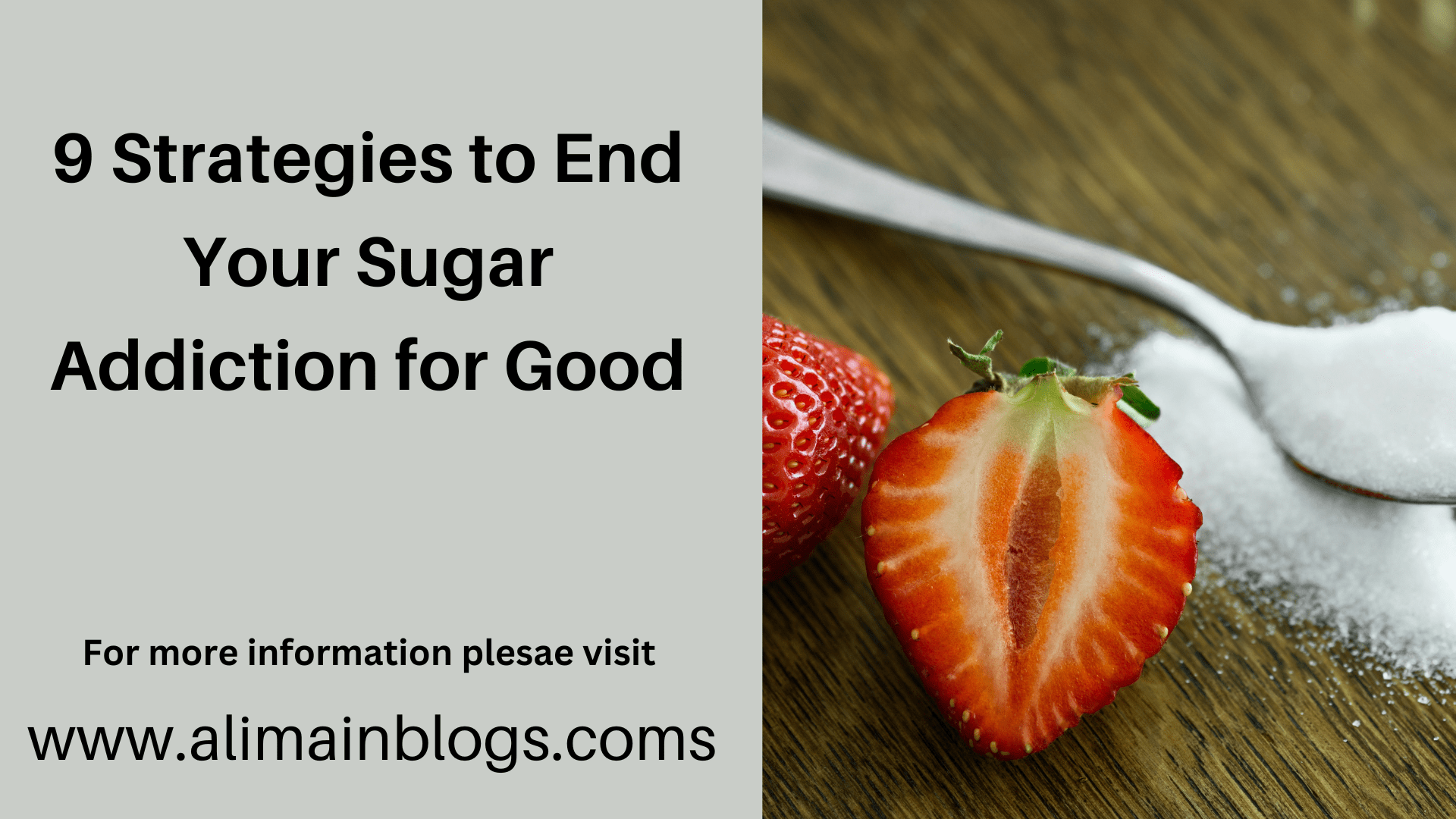9 Strategies to End Your Sugar Addiction for Good. You might be startled to find that the average American consumes more than three times as much sugar. As the American Heart Association recommends—22 teaspoons—per day (AHA). 1 Although sugar has never been seen as a healthy food. It can actually be detrimental to your health, increasing your risk for heart disease, type 2 diabetes, and obesity.
Yet giving up sweets might be difficult. According to research neurologist Nicole Avena, PhD, it’s difficult to avoid because it lurks in so many meals and offers an almost addicting sensation thanks to an increase in the neurotransmitter dopamine when it enters the body. Why Diets Fail (Because You’re Hooked to Sugar) was written by Avena.
One culinary trend worth experimenting with is reducing sugar. Learn everything there is to know about quitting sugar, including what you can do to keep your promise.
How the Body Reacts to Sugar

When you consume foods that are high in sugar and carbohydrates. Your body releases the hormone insulin, which is made in the pancreas. Blood sugar levels are stabilised by insulin.
What gives you that sugar rush is an increase in dopamine and serotonin, two “feel-good” chemicals found in the brain. According to nutritionist Brittany Kohn, RD, of New York City. A blood sugar dip results in a sugar crash, which leaves you feeling exhausted, groggy, and agitated.
However, consuming too much of any sugars can result in serious health issues. 16 calories are in one teaspoon of sugar. It might not sound like much, but according to Avena. It can soon add up to hundreds of calories without providing any nutritional value. Increased calorie intake increases your chances of obesity, which puts you at risk for type 2 diabetes.
According to a 2013 study, the prevalence of diabetes increased by 1.1% for every population of 150 calories or the equivalent of one can of soda that consumed added sugar.
Moreover, studies have linked sugar to heart disease. According to a 2014 study published in JAMA: Internal Medicine, a person’s risk of dying from heart disease increased with the amount of added sugar they consumed.
This doesn’t imply that you should never consume sugar again. But cutting back, especially on some sugars, will boost your health.
These are nine strategies to help you stop eating sugar.
Acquire Label Reading Skills
There are several names for sugar. Maltose, sucrose, high fructose corn syrup (and anything else ending in “ose”), molasses, cane sugar, raw sugar, syrup, honey, corn sweetener, and fruit juice concentrates are other names for sugar that you can see on an ingredient list.
The Nutrition Facts label, which includes “added sugars” and “total sugars,” can also be used to determine how much added sugar is present in a particular meal.
A product with 15 grammes of sugar per serving has 60 calories, not including the other ingredients, since one gramme of sugar has four calories.
Eliminate White Sugar
Refined white sugar, the kind you put in coffee or that is added to baked products. Is the main sugar offender to avoid. This simple sugar is readily absorbed by the system, resulting in spikes in blood glucose and insulin levels that can cause serious damage to the body, according to Avena.
Several processed food items, such as ketchup, bread, salad dressing, and beef jerky, all include refined sugar in addition to the ingredients listed above (e.g.,cane sugar, high fructose corn syrup).
While not often being processed in the same way as refined white sugar, molasses, honey, and maple syrup nonetheless have a negative impact, according to Avena.
Don’t Drink Sugary Beverages

The hidden sources of added sugar include soda, fruit juice, sports drinks, iced tea, and other sweetened beverages. For instance, a can of soda has nine teaspoons. Which is already one-third more than the six teaspoon daily limit advised by the AHA1.
Seltzer can be used in place of soda because it has no added sugar and contains no calories, according to Avena, who claimed that sweetened beverages and drinks prepared from fruit juice are “like liquid sugar” and add plenty of calories without satisfying hunger. Replace bottled water with fruit infusions or water with fresh fruit slices added for beverages with fruit flavours and fruit juice.
Don’t Believe Artificiality Is the Solution
It might not be possible to avoid the sugar problem by substituting artificial sweeteners like aspartame or saccharin for sugar.
According to Kohn, artificial sweeteners give food a pleasant taste without adding calories, so when you eat these foods, hunger isn’t satiated, making you want more later. Drinking just one diet Coke per day is associated with weight gain and diabetes, according to a 2013 study published in Trends in Endocrinology & Metabolism.
Why do artificial sweeteners increase appetite? It’s unclear, but it might have something to do with how intensely sweet these things are. As artificial sweeteners are much sweeter than natural sugar. They might blunt your taste buds to mildly sweet items like fruit and increase appetites for foods high in sugar and calories, according to Kohn.
Remove Simple Carb Treats
White bread, pastries, muffins, and other baked goods manufactured with refined flour are low in nutrients but high in added sugar, which can disrupt blood sugar levels. According to Kohn, this creates a cycle where people continually grab a muffin or donut for short-lived energy.
Get your carb fix instead from whole grain types. They are digested and turned into sugar. But because they are complex rather than simple, they are taken more gradually and give off steady energy.
Eat Less Sweet Restaurant Food

It’s not called sweet and sour pork by accident. In many cases, the sauces or coatings on takeout or restaurant food contain additional sugar. Although you might not taste it. Even the crust of takeout pizza is likely to contain hidden sugar, according to Avena.
She continues that sugar is frequently added to glazes, condiments, and even pasta sauces, the same sugar that is just as hazardous in a box of prepared cookies.
Don’t give up completely
According to Kohn, abruptly quitting sugar can produce withdrawal symptoms including headaches, anxiety, and mood changes because our systems are so accustomed to sweet foods. Have you ever skipped your morning coffee or other caffeine fix? That describes sugar withdrawal ten times more.
To give your body time to adjust. It is preferable to gradually wean yourself off of it by taking one step at a time, according to Kohn. Another reason to take your time is that slower adjustments, especially when it comes to giving up sugar, have a tendency to stick, according to Avena.
Give yourself time to gradually break the habit of adding sweetness to your food and beverages. If you’re used to doing so, said Kohn.
If you usually start your day with two spoonfuls of sugar or honey in your tea or coffee, try cutting back to one for a week and then to zero the following week. You can also add an orange slice or a little milk to the beverage to make it sweeter. Use the same logic when adding sugar to your cereal or maple syrup to your pancakes. It will be less obvious that you’re cutting back if you gradually decrease the amount, and you’ll experience fewer sugar cravings as a result.
Add a lot of protein and good fats.
When trying to give up sugar, increasing your intake of lean proteins like eggs, turkey, and legumes and healthy fats like nuts, olive oil, avocado, and dairy is a recommended plan of action. Both help you feel full and energised while minimising blood sugar swings that often trigger difficult-to-avoid sugar cravings. Eating both foods is also generally healthy.
Eat eggs and avocado for breakfast rather than the customary starch and sugar combination, such as a muffin or sweetened cereal, said Kohn.
Recognize “Good” Sugars
Natural sugars like fructose in fruit and lactose in dairy products can be found in diet and do not need to be eliminated. As long as you eat these in their natural edible form, you’re okay.
According to Ayurveda, the amount of sugar in fruit is better matched to the amount of fibre and other nutrients present. “These other nutrients counteract the negative effects of sugar.”
Simply peruse your spice cabinet to sate a sweet appetite without turning to refined varieties. According to Kohn, adding cinnamon or vanilla extract to coffee, cereal, or baked goods imparts a sweet flavour without the negative consequences of sugar and has no calories.
Chicory, ginger, nutmeg, and cardamom are additional sweet herbs and spices that can be used in meals and beverages. Moreover, citrus zest offers a delicious, energising taste.
—————————–
Q&A
How can I give up sugar for good?
Here’s how to stop eating sugar. Remove all sweets from your house first. Substitute them with fruit and low-sugar alternatives that are healthier sweet selections. Put nuts in your biscuit pan, and replace the sugar in your porridge with a teaspoon of honey.
Why am I unable to cut back on sugar?
Many people frequently have desires for sugar. Health experts think that this is one of the key causes of why it can be so difficult to maintain a balanced diet. Your brain’s demand for a “reward” drives cravings, not your body’s hunger.
A sugar detox lasts for how long?
Reduce your sugar intake right away. According to the Ohio University Medical Center, a sugar detox will last 3–10 days. The lengthier the detox will take, the more sugar you typically consume. The good news is that, in contrast to other addictions, the severity of the symptoms will lessen as time passes.
———————————-
FOR MORE INFORMATION PLEASE VISIT: alimainblogs.com

Excellent blog here! Also your web site loads up fast! What host are you using? Can I get your affiliate link to your host? I wish my web site loaded up as quickly as yours lol
Hey, you used to write wonderful, but the last several posts have been kinda boring?I miss your great writings. Past few posts are just a little bit out of track! come on!
Thank you for any other great article. Where else could anybody get that type of information in such an ideal means of writing? I’ve a presentation subsequent week, and I am at the look for such information.
Thanks for posting. I really enjoyed reading it, especially because it addressed my problem. It helped me a lot and I hope it will help others too.
Great information shared.. really enjoyed reading this post thank you author for sharing this post .. appreciated